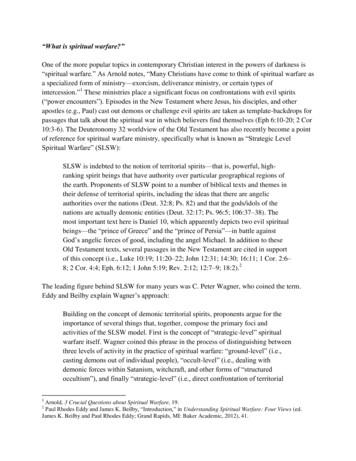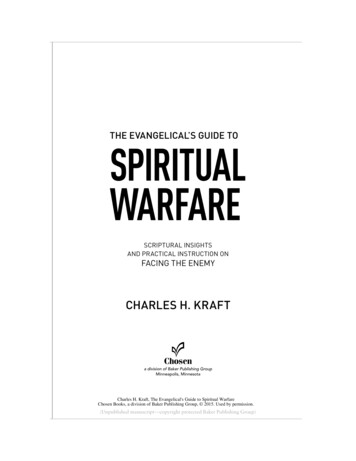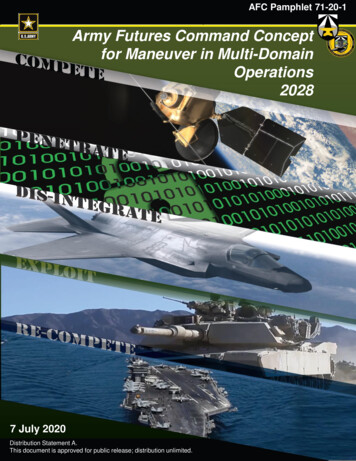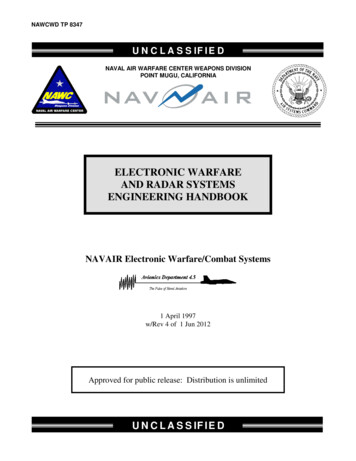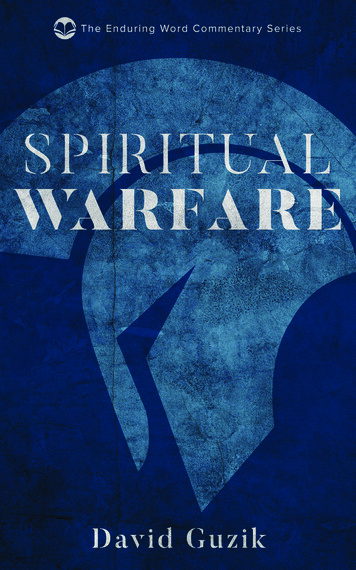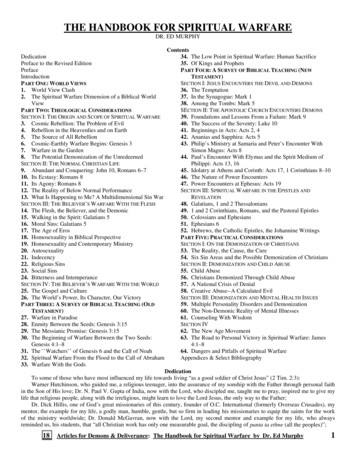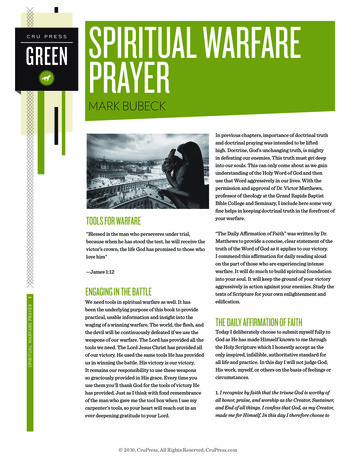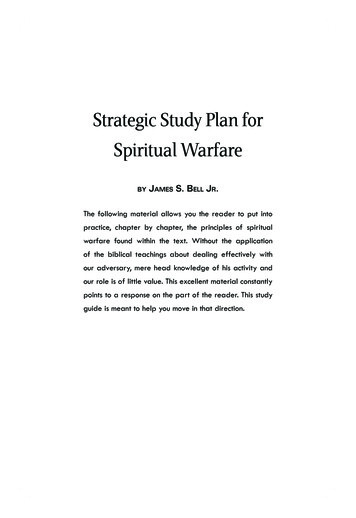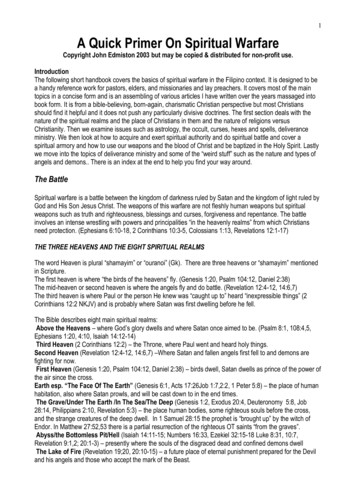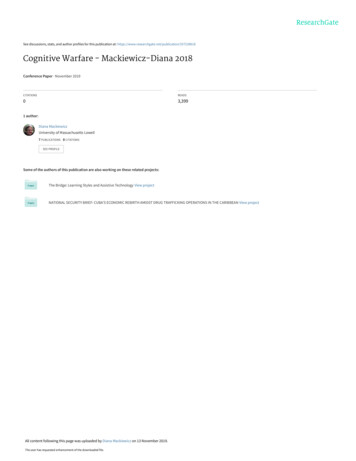
Transcription
See discussions, stats, and author profiles for this publication at: Cognitive Warfare - Mackiewicz-Diana 2018Conference Paper · November 2019CITATIONSREADS03,3991 author:Diana MackiewiczUniversity of Massachusetts Lowell7 PUBLICATIONS 0 CITATIONSSEE PROFILESome of the authors of this publication are also working on these related projects:The Bridge: Learning Styles and Assistive Technology View projectNATIONAL SECURITY BRIEF: CUBA’S ECONOMIC REBIRTH AMIDST DRUG TRAFFICKING OPERATIONS IN THE CARIBBEAN View projectAll content following this page was uploaded by Diana Mackiewicz on 13 November 2019.The user has requested enhancement of the downloaded file.
COGNITIVE WARFARE:Hamas & Hezbollah and their insidious effortsCourse: Islamic Jihadi-Salafi Terrorism as an Ongoing ChallengeInstitute of National Security StudiesTel Aviv, IsraelDiana T. MackiewiczSubmitted: 16 November 2018
1Cognitive warfare, when practiced effectively has strength, an insidious nature and disruptsour ordinary understandings and reactions to events. The term, cognitive warfare, requires somedissection and interpretation in the context of national security; broadly defined it is adisinformation process to psychologically wear down the receivers of the information. It isstrategically spread through information resources like social media, networking, Internetresources, videos, photos taken out of context, simplistic resources like political cartoons andeven well-planned websites that encourage the making of disinformation. It is the,“ manipulation of public discourse by external elements seeking to undermine social unity ordamage political trust in the political system.” (Rosner & Siman-Tov, 2018)For those in the military, cognitive warfare is considered the 5th generation of warfare since itis used as a form of hard power while appearing innocuous. Modern day military and nationstates now face the onslaught of disinformation that is designed to discredit credibility andconfuse the public of plausible and truthful details. According to US Lt. Gen. Vincent Stewart,in a keynote address to the Department of Defense Intelligence regarding the age of cognitivewar, “There are about 3.7 billion people connected to the Internet now-that’s almost half ofhumanity with the ability to consume and share information in the blink of an eye andeven steal some of our information and private conversations.” (Stewart, 2017)Hamas and Hezbollah have employed a steady discourse of misinformation and deceit againstIsrael to engender worldwide support and humanitarian aid for the Palestinians. Meanwhile,Israel has had to regroup and consider an inherent national strategy for cognitive warfare whileallowing civil liberties to prevail in a democratic society. (Rosner & Siman-Tov, 2018)Therefore, the focus of this study is how Hamas and Hezbollah have applied cognitive warfarePage 1 of 19
2and how the country of Israel has dealt with the ongoing effects of cognitive warfare fromterrorist organizations.2. Literature reviewThe use of misinformation, deceit and under-handedness in warfare has a long history. Onecan quote from The Art of War by Sun Tzu written during the Warring period of China (475221BCE) relating to cognitive warfare,“Thus, it follows that the highest form of warfare is to out-think the enemy . thus, askillful general must defeat the enemy without coming to a battle, take his cities without asiege and overthrow his state without a long campaign ” (Trapp & Sun Tzu, 2012)For this research, a current starting point of reference and review of cognitive warfare beginswith Osama bin Laden and his own communication of Al-Qaeda’s intent. Max Abrahms (2005),“Al Qaeda's Miscommunication War: The Terrorism Paradox,” examined the psychological andpolitical misperceptions that were conveyed by Al Qaeda. Abrahms directly states that terrorismis a form of communication and that the messages that Al Qaeda employed against the UnitedStates were consistent but not effective. The consistency was in the three points often quotedand now historicized: 1) Al Qaeda wanted to drive the American military from Muslim Holysites in Mecca and Medina, 2) Al Qaeda was against the U.S. involvement in Iraq and thatincluded Operation Desert Storm, 3) Al Qaeda “condemned” the U.S. Israeli alliance and U.S.assistance with Israel and its war against Palestine. (Abrahms, 2005)Furthermore, Al Qaeda proceeded to narrate America as the ultimate villain due to its militaryprowess which was akin to “killing a fly with a shotgun.” (Abrahms, 2005) The messages sentout by Al Qaeda challenged America’s credibility and international standing and finally, on 11September 2001, America was attacked in what seemed like a surprise. Al Qaeda understoodPage 2 of 19
3America to be a “paper tiger,” ineffectual and not much of a challenge based on past incidents,such as the bombing of the U.S.S. Cole and the embassy bombings in Kenya and Tanzania.(Abrahms, 2005)Yet the paper tiger rationale did not work because Al Qaeda and the rest of the world reactedto the message sent. Here the cognitive warfare approach is explored because the receiver of themessage (United States, George Bush) had to conciliate the sender (Al Qaeda, Bin Laden) andcommunication had to succeed at two levels. The receiver needed to understand the messagecommunicated by the sender. Second, the receiver had to believe that the sender’s messageaccurately stated the intentions of the sender, all equaling clarity of communication andintention. (Abrahms, 2005)President Bush’s reactions have been well documented but in this analysis one can suggestthat he used “premature cognitive closure” based on the fact that Bin Laden was considered the“little terrorist in Afghan,” (Abrahms, 2005). Bush chose to swiftly react which was a reactionto the fast and far reaching effects of the events and that he enacted his own defense mechanismsbefore taking stock of all the countervailing information. (Abrahms, 2005)One can also argue if Bush really believed all the signals sent from Al Qaeda were clear intheir intentions or another smokescreen. How does the belief in the other side’s message applyto Israel and Hamas? Victims of aggression are often suspicious of making any compromiseswith the “winner” since winners may use it to their advantage and demand more of the “loser.”(Abrahms, 2005) Therefore, does Hamas feel that making concessions with Israel then imply thatIsrael is the winner and Hamas will have to follow through on future concessions?Page 3 of 19
4The substantial tool that Al Qaeda gained from 9/11 was the coverage by the media of theevent. Two-thirds of the world watched the event on TV, Internet and the news cyclerebroadcast the footage of the planes flying into the Twin Towers several times. Media coveragefor terrorists is considered “oxygen of publicity” (Thatcher, 1985) and this phenomenonhighlights the violence of the terrorist attacks and often does not portray the humanitarian andeconomic issues that create the grievances. (Abrahms, 2005) In addition, terrorist organizationsrely on the media, social networking, videos, photos because these groups do not have adiplomatic body that is internationally accepted and institutionalized in the process ofcommunications. (Abrahms, 2005)Moreover, a major concern for cognitive warfare is when the enemy does it better,accomplishes their directives and remains in power despite all the futile attempts to thwart theirskills. “Psyoping Hezbollah: The Israeli Psychological Warfare Campaign During the 2006Lebanon War,” by Ron Schleifer, (2009) explains Israel’s attempts to defeat Hezbollah in the2006 War between Israel and Hezbollah. The decision by the Israel Defense Forces (IDF) toemploy psychological warfare, known as PSYOP against the terrorist group, Hezbollah, locatedin Lebanon was a complicated and tactical risk for the IDF. Psychological warfare in themilitary context focuses on the following three addressees: domestic, enemy and neutral, and allare exposed to carefully crafted messages. (Schleifer, 2009) The compounded effects that signalsuccess are that the audiences will choose to act, support, oppose or remain neutral to whatevents are taking place. (Schleifer, 2009)The practice of psychological warfare is not a new component for warfare but for the IDF,they had already scrubbed their PSYOP division six years before the campaigns againstHezbollah and had to regroup and form a new unit in 2005 called, Mercaz L’Mitzaei Toda’a:Page 4 of 19
5The Center for Consciousness/Perception Operations or also known as MALAT. (Schleifer,2009) The first mission was hastily pulled together against Hezbollah and had merit afterlearning from mistakes made.Schleifer makes it apparent that the early days of MALAT could have also terminated itsexistence because it was working with two other elements: effects-based operations (EBO) andItsuv HaMa’aracha (Battle Design) also known as GHQ. The EBO does not involve a fullonslaught with the enemy but favors things like precision bombing, drone strikes and EBO wasthe “new” warfare. (Schleifer, 2009) Whereas, Battle Design was also included in the operationsand this added further conflict to operational and organizational communications. (Schleifer,2009) A non-militaristic point of view would suggest that there were too many theories andguidelines in place for the start-up of MALAT in 2005.What is noteworthy about MALAT and EBO intandem was that a plan was developed to discreditthe leader of Hezbollah, Hassan Nasrallah, therebyeliminating his command in the field and overallcommunications with Hezbollah troops. (Schleifer,2009) The action to build a cognitive warfarecampaign against Nasrallah involved fundamentalstrategies like the use of caricatures (political cartoons), leaflets dropped on Lebanese towns andvillages discrediting him, making fun of him in the news and on the TV and discrediting himpublicly forcing his followers to reconsider how to support him. (Schleifer, 2009) Figure 1:Leaflet produced by Israeli Defense Force for Israel-Lebanon War 2006 “Your defenders arePage 5 of 19
6your destroyers” Large head of Nasrallah behind the human shield of Lebanese citizens.(Richards, 2012)The PSYOP campaign delved into the power of persuasion and targeted the Lebanese citizenswho had built a support for Nasrallah and Hezbollah. The rain of leaflets was targeting the otherdistinct groups: Druze, Christians and Sunnis who had not aligned with Nasrallah. Interestingly,a challenge the MALAT unit encountered was how to convince the Lebanese to read the leafletswhich were dropped from planes that were avoided whenever seen flying overhead. (Schleifer,2009)Was the cognitive warfare against Hezbollah, especially Nasrallah a complete success? Thedecision is divided since Hezbollah never left Lebanon, Nasrallah is still in charge, but thefractures of public support were initiated. Without a victory, Israel had to settle for the fact thattheir cognitive warfare skills executed under MALAT needed to improve. The Israel Lebanonwar in 2006 was a 33-day event and it was not enough time to establish a full drawn out“psychologically based process of persuasion.” (Schleifer, 2009)In fact, the weak outcome for Israel became a significant learning experience that hadstrengthened the IDF’s resolve to improve their PSYOP methods. For example, they committedto the idea that all military events needed a name, and the war in 2006 became known as “TheSecond Lebanon War.” Hezbollah named the war in 2006, “Divine Victory”, and regaled in thefact that they had held off the IDF with a fighting force of 600-800 fighters and survived.(Schleifer, 2009)What Israel and the IDF learned from all the experiences attributed to the victory/no-victoryin Lebanon was explained more fully in the research by David Siman-Tov and David Sternberg,Page 6 of 19
7(2017), “The Missing Effort:” Integrating the “Non-lethal” Dimension in the Israeli MilitaryLines of Operation. The bulk of information and data streaming into households via the Internet,TV, radio, newspapers and several computer devices is greater today when compared to theevents of 9/11 which was seen by over 2/3 of the world population. The publicity of 9/11 fueledthe mindset of many terrorists and could not be contained by the media, especially in democraticcountries. Now in 2018, the direct pipeline to communities is through the media and in ademocratic country, civil liberties and thirst to know the story work side by side. The civilliberties protect the power of free speech and allow the media to function in its ability to informthe public.Yet nations, especially democratic ones like Israel, United States, France, encounter intrinsicchallenges “controlling” the media and how to express the opinions posed. Lethal force in theform of armies and attacks have also been criticized for the damages caused and loss of life. Themilitary force may be defined as a kinetic force, hard-driving linear forceful action. The nonkinetic force, also referred to as “soft-power” is manifested in the economic and diplomaticsanctions, legal forces, even the manipulation of information which falls into the category ofcognitive warfare or perception management as it is often referred to in the United States.(Siman-Tov & Sternberg, 2017)The power of persuasion through cognitive warfare is a troubling concept because asexpressed in Siman-Tov and Sternberg’s work, the IDF needed to enhance their own abilities topersuade and “adopt the logic of influence operations.” (Siman-Tov & Sternberg, 2017) Theability to take information and disseminate it across several platforms: computer, Internet, TV,newspaper and leaflets, ultimately controls the narratives projected and questions aboutauthenticity and attribution may not be checked.Page 7 of 19
8Therefore, a strategy against cognitive warfare requires a useful adage, “Know Thyself,”attributed to Socrates and located at the Temple of Delphi. Knowing yourself and knowing yourenemy is a stronger dictum for success and this knowledge through intelligence resources,media, reports and first-hand accounts especially shape how cognitive warfare will impact publicsupport, opinions, and decision-making. (Siman-Tov & Sternberg, 2017)Israel’s model for cognitive warfare as explained in (Siman-Tov & Sternberg, 2017) outlinesthe use of media, electronic warfare, and financial and cybernetic campaigns. These tools arevaried in their use and have had some success however they have not been made as apparent on aworld stage. For example, the use of humanitarian aid not only to Israel’s allies but also toneighboring enemies is not well known. A recent Jerusalem Post article, 16 October 2018,mentions that for a second time an infant of Syrian refugees living in Cyprus is returning toIsrael for a needed operation. The story was displayed on Twitter via the Internet and yet storieslike this do not consistently filter down to populations around the world. Yet, if Israeli’s knewthis about their country and the humanitarian services it has established, would this assist Israel’sreputation at home and abroad? One may also suggest that the publicized humanitarian serviceis a soft power that is non-lethal in description and bridges many perceptions of distrust.However, cognitive warfare and the use of the Internet and media outlets is a time-consumingprocess that resides often outside the military institutions and its leaders. Within the IDF there isa strong and visible practice that actions matter over words and the outcomes are definitiveachievements, that can be quantified and are attained quickly. With cognitive warfare, theresults are “slow,” hard to assess for success, and often difficult to discern. (Siman-Tov &Sternberg, 2017) Therefore, an approach to discredit an adversary via the use of propagandatools: leaflets, memes, and cartoons may not be efficient and timely in a world where messagesPage 8 of 19
9like videos, texts and images travel in nanoseconds. But the psychological operation ofproviding plausible details and lies to discredit and confuse the enemy as used in leaflets andmemes has a strong operational value in modern methods of communication. (Siman-Tov &Sternberg, 2017; Siboni, 2018)For Israel and the IDF, the following suggestions about augmenting current cognitive warfareand success were made: Information Warfare: Focus on the person, organization, their message, pertinentgroups and know the adversary’s audience: local, regional, international and are theyliterate. (Siman-Tov & Sternberg, 2017) Political-Legal Warfare: Utilizes the legal systems in place to defend Israel from legalclaims, expression of ethical and legal concerns through practices like early warnings tothe enemy and proactively protecting Israel from ongoing lawsuits. (Siman-Tov &Sternberg, 2017 Economic Warfare: Damage, upset, curtail the enemy’s economic resources to protectIsrael from outside terrorist threats. (Siman-Tov & Sternberg, 2017 Cyberwarfare: Proactive approach to protect Israel’s national security and reputationthrough cyberdefense and the use of information, intelligence collections, cognitivewarfare, psychological warfare cohesively woven into the fabric of media, economics,and national security. (Siman-Tov & Sternberg, 2017) Know Thyself: Israel and the IDF, through constructive reflection and criticism, knowwho they are, where they want to be and maintain the knowledge of their own political,cultural and religious history. It is an exercise in self-knowledge which will enable allPage 9 of 19
10Israelis to further defend their values as a free, moral and democratic country. (Kozloski,2018)Hence, cognitive warfare as practiced in Israel needs a robust upgrade in the 21st century.Attention to time frames on the release of powerful images, to the reaction time and numbers ofreactions (views, hits) need to be assessed. Attention to how videos and images are plausible inone context and then imported into another context representing deceit also need further study.Finally, within the article by Siman-Tov and Sternberg, there is the conclusion that mechanismsto measure and interpret media resources and then rapidly reply with accurate information andknowledge is needed.3. Application of AnalysisThere are many audiences that are drawn into the vortex of misrepresentation and deceit whencognitive warfare is routinely practiced. Vulnerable audiences are those that conceptualize andgather information more from images than from language, audiences that have been raised in asectarian perspective that diminishes any possibility of a resolution, and foreign audiences thatdo not have the background information to critically analyze the product and refute its message.A useful framework to follow is a triangle of communication as described by Brigitte Nacos,“ terrorists calculate what they need and will get access to what one might call thetriangle of political communication. The mass media, governmental decision-makers,and the public constitute the corners of the triangle.” (Nacos, pg. 361, 2016)Domestic communication resources are the most important for the terrorists and these willinclude information technologies, TV stations, newspapers and of course the ubiquitous socialnetworking campaigns. The medium of memes, cartoons and videos are appropriate tools forPage 10 of 19
11cognitive warfare and often their targeted audiences share these qualities: young, technicallysavvy, educated, worldly and a range of knowledge about international political events.The deliberate use of misinformation to threaten, distort and coerce when applied to theperspective of the young learner creates a cumulative effect since there is no other frame ofreference. Children and adolescent audiences are exploited through the substantial use of TVand Internet related devices; cognitive warfare practiced at this young educational level needsjust as much attention as the cognitive warfare practiced on adults.3.1 MemesMemetics have been in use since the 1970s and astools for psychological warfare, memes, provide arealm of detachment while the responder interreactsand develops their own opinion. The adjacent meme,Figure 2, is credited to the website, Standwithus.comand constructed from clear photographs,grammatically correct for an English-speakingaudience, and published online since March 2018. (Teaching Children to Hate, 2018)The above meme is an attempt by a pro-Israeli group to discredit Hamas and Hezbollah.Ironically, Hamas and Hezbollah have advertised that they train their children to kill, hate andpractice martyrdom. A technical feature about the meme is that it is easily disseminated acrossseveral social networking platforms: Twitter, Facebook, Reddit, WhatsApp and of courseInternet websites. The meme heightens awareness about the enlistment of children by Hamasand Hezbollah as child soldiers and reinforces the idea that Israel is a peaceful partner.Page 11 of 19
123.2 Websites that TeachTwo websites that are currently active and available to adults and children also have theability, in the “right” hands to shape perception management for positive and negative results.Storyboardthat.com, and Palestine Remix: You Can Tell the Story Too, sponsored byAljazeera.com. Both sites are geared for a young technocratic audience and analyzed below.3.2a Cartoons-Amateur and ProfessionalThe above cartoon, Figure 3, was made on Storyboardthat.com, 10/18/2015. Age of the creatoris unknown, but the cartoon establishes the tone of how Israelis and Palestinians are not willingto help each other. Access to the software is free and continued usage is a monthly or one-timecost. The use of the software instills in the creator a creative freedom and independence. It is anamateurish design meant to engender inaccurate portrayals of the two societies and propagandizeone side’s narrative. The Palestinians in the Gaza and West Bank receive water from the State ofIsrael at cost. The message the cartoon conveys is how Israelis and Palestinians are willing tokill each other over food and water resources. Cartoon was removed from Storyboardthat.comrecently in fall of 2018.Page 12 of 19
13Furthermore, cartooning and caricatures messaging increases in sophistication with age andexperience, as shown below. The messages become timelier and nuanced in meaning. The twocartoons are made by professional cartoonists and have a stronger condensed artistic style.An American editorial cartoonist drew this cartoondepicting how Hamas and Hezbollah train their youngto hate and kill Israeli Jews. The use of TV characterslike Barnie the Dinosaur and a Sesame Streetcharacter convey that terrorist training begins at avery young age and that TV is available.Figure 4: Published August 21, 2012 by SteveGreenbergAAEC Ref Num: 114037 (Greenberg, 2012)A Palestinian drew this cartoon which depicts Israelisettlers as heartless for their actions when they torchedhomes in the Duma village near Nablus. An 18-month-old baby died and his family was severely wounded.The style is simplistic and contingent upon theaudience, a moth too close to a flame will get burned.The moth could also be a butterfly.Figure 5: July 13, 2015 (Sabaaneh, 2015)Both cartoons depict a knowledge of current events, and international media as in the case ofFigure 4 with Barnie the Dinosaur and a Sesame Street character chanting anti-Israel deathslogan to a young child, representative of child soldiers in Hamas and Hezbollah. Figure 5 hasfew words in it suggesting simplicity, strong non-verbal communication through the symbolsused and the choice for no words. The cartoons have directed messages at local, regional andinternational audiences designed to simultaneously produce sympathy and disgust for theintended target.Page 13 of 19
143.3 Videos and Cognitive WarfarePalestine Remix: You Can Tell the Story Too, sponsored by Aljazeera.com, provides thecompiler of the video with archived videos, interviews and images about Palestine. Thecompiler of the video, then has the option to upload it to Facebook, Twitter, Google , or email it.The technical directions are uncomplicated; in English, Arabic, Bosnian and Turkish, and thewhole service is free. One video on the website, Beyond the Walls, (Al-Rahmy,2012), has aninfluential professional style that portrays prison as routine and depressing with well-drawnvisual images that transition from one frame to the next. For the uninformed viewer, it illustratesa despotic and dire message about imprisonment of Palestinians for political crimes after the SixDay War in 1967 by the Israeli’s. The message of the video also supports the Palestiniannarrative about Israeli prison systems and justice. The film director was Ahmad Adnan AlRahmy, and this production was overseen by Rawan Damen, senior filmmaker and mediaconsultant at Al-Jazeera. After several comparison views to other projects at Palestine Remix,one can see the differences between a professional and amateur remix project.Rawan Damen contributed her expertise to The Price of Oslo (2013), which launches a onesided point of view that the Oslo Accords were more about establishing land settlements forIsrael and not for future peaceful relations.The disarming feature about both films mentioned is that they are made by experienced filmcrews with strengths in cognitive and psychological warfare. The less robust and amateurishfilms at Palestine Remix portray passion mixed with historical bias and are not comparable tothe films listed above. Finally, if one wanted to remix a video that was unbiased, there is no wayto introduce an outside video resource into the ones supplied by Aljazeera.com.Page 14 of 19
153.3a Hezbollah – Capabilities and Role in The Middle East (Full Documentary)https://www.youtube.com/watch?v tzBZpNxkui8 Published: 18 Nov. 2017Fig. 6 The screen shot from theHezbollah documentary hasprofessionally blended images ofHezbollah’s army, their leader,Nasrallah and states clearly thatits roots were first “intraLebanese” but later were supported by the Syrians and Iranians. The video is less than one yearold, over 318,000 views and does not try to conceal who the outside supporters are for Hezbollahand what their goals are: targeting Israel, assisting Hamas, strengthening the role of Iran andShiitism. (Hezbollah, 2017)3.3b “Hamas indoctrination of Kids: Bombs more precious than children”https://www.youtube.com/watch?time continue 7&v uVAVluvE0W0 Fig. 7Published: 11 January 2009. The video hascobbled together video segments of childrentraining as Hamas soldiers, children acting incertain video segments with people who aretheir parents, interviews with very youngtoddlers who are already answering questionsabout killing Jews. The Hamas messagedoes not suppress hatred for Israeli Jews, nor does it shy away from training children to fight asPage 15 of 19
16soldiers. Finally, the message of martyrdom is significant since children are emotionally beingprepared to plan for suicide bombing missions. The video has had over 3,747 views. (Childrenof Hamas, 2009)Palestinian Media Watch, palwatch.org is a nongovernmental organization that translates thevideos, cartoons, media that are produced by the Palestinian Authority and associates. Theirmission is to encourage peace and eventual cooperation among Israel and her neighbors andmonitor the media despite how inciteful it is. In an unobtrusive manner, Palwatch.org seeks toraise the awareness of its viewers and explain in detail the truth. Therefore, Palestinian MediaWatch’s approach to cognitive warfare is to clearly define the misinformation listed and toexplain publicly what it means.4. ConclusionThe cognitive warfare campaign staged by Hamas and Hezbollah has exploited several meansof communication, especially within the realm of TV, movies, memes, cartoons and theapplication of an Internet platform. The cognitive warfare has been insidious and relentless in itspropaganda and overt messages of hatred and defeat of Israel and Zionism. The frenetic pace ofthe release of movies and memes for public consumption has been counteracted by Israelinongovernmental institutions, the IDF and the Israeli public. A more stringent maneuver may bethe continued removal of movies, websites and social networking sites that promote the hatredand propaganda against Israel. Removal of the “oxygen of publicity.”Finally, as of 12 November 2018, the Al Aqsa TV station located in the Gaza, whichbroadcast many TV shows meant to indoctrinate young Palestinians as the “cubs” for Hamas andHezbollah was destroyed by IDF rocket fire. (Rasgon, et al, 2018) A cynical realist may suggestPage 16 of 19
17that the TV station will be rebuilt, and Hamas and Hezbollah will then bolster their cognitivewarfare campaign but for now, “no news is good news” when it comes to propaganda campaignsin its highest form of cognitive warfare. Meanwhile, Israel has an opportunity to regroup andupgrade their own messages of peace, humanitarian aid, and potential prosperity when there ismutual trust and cooperation.Page 17 of 19
18ReferencesAbrahms, M. (2005). Al Qaeda's Miscommunication War: The Terrorism Paradox. (4), 529-549.doi:10.1080/095465591009421Al-Ramhy, A. A. (2012). Beyond the Walls - PalestineRemix. Retrieved October 31, 2018, eremix/beyond-the-walls.html#/3Bollag, U. (2018, October 16). Syrian refugee baby returns to Israel for second life-savingoperation. Retrieved October 20, 2018, from ren of Hamas. (2009, January 10). Retrieved November 17, 2018, fromhttps://www.youtube.com/watch?time continue 7&v uVAVluvE0W0Damen, R. (2013). The Price of Oslo - PalestineRemix. Retrieved October 31, 2018, fromhttps://interactive.aljaz
war in 2006 was a 33-day event and it was not enough time to establish a full drawn out “psychologically based process of persuasion.” (Schleifer, 2009) In fact, the weak outcome for Israel became a significant learning experience that had strengthened the IDF’s resolve to
